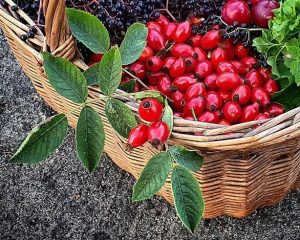Rosehip ketchup & syrup recipes
The hedgerows seem to be heaving with rosehips this year!
These under-appreciated red beauties are abundant, native, free, and packed with goodness including more nearly 9 times as much vitamin C by weight than oranges (oranges 53mg per 100g versus rosehips 426mg per 100g!) so it’s utterly crazy that we don’t utilise this incredible resource more than we do. Roses are related to apples and so the hips are fruity and naturally sweet when ripe.
The rosehips need to be fully red, but you don’t have to wait until after the first frosts to use them for a traditional-style ketchup or a syrup. You can freeze them if you like to break down the cell walls and/or to do your processing at a later date, but I used fresh rosehips for these recipes and they were bright red and firm but not rock hard, they did give a teensy bit when squeezed. If you’re going to cook them anyway, this is just perfect s they’re dry and easy to pick, no mess, and they keep a few days in the fridge until you have time to process them. For wild rose hips, don’t pull them off the stems, snap them off sideways, it’s much quicker and easier. Watch the thorns, especially on the Japanese or beach roses, they have way more than the wild rose.
Rosehip varieties
All rose hips are safe to eat, however certain species produce more useable hips than others:
- I mostly use the UK-native wild rose or dog rose (Rosa canina) with small slender oval fruits between 1-2cm long, they have great flavour, colour and a natural sweetness, the petals smell nice too, usually in pale pink, they’re thorny on the main briars but not on the stalk of the hip

- Another good species for foraging is the beach rose or Japanese rose (Rosa rugosa) which has huge, cherry-tomato-like hips with lots of sweet flesh on and incredibly fragrant petals as well, usually in shocking pink or white, all stems are covered in tons of fine densely-packed spines so be careful

- I also use burnet rose (e.g. Rosa pimpinellifolia) which usually have black hips! These make a fabulously dark vodka if infused, or an interesting syrup, the petals are typically white and slightly fragrant, stems are incredibly spiky so go slow or use gloves
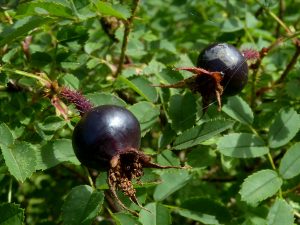
Rosehip purée
De-stalk, wash & cook rosehips in enough water to cover them until soft, smoosh as much as you can through a sieve. Mine ended up exactly the colour, thickness and texture of Heinz tinned tomato soup! The irritant hairs around the seeds don’t seem to be an issue once cooked and strained with a fine sieve. I tend to pass it twice to be sure it’s smooth. (If you pass it through muslin you will lose most of the pulp which is not ideal for ketchup).
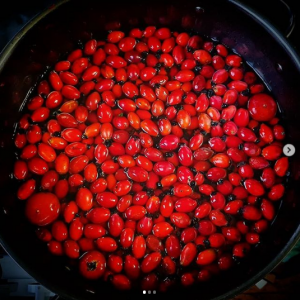
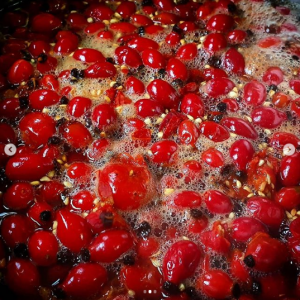
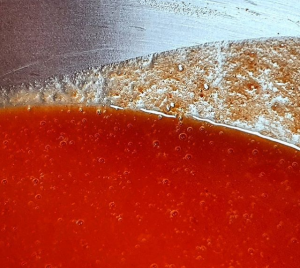
Rosehip juice
You can also re-suspend the seedy pulp in more water after first pass, sieve again (much easier second time!) and keep the looser suspension as rosehip juice e.g. for cocktails or just drinking, full of vit C (boil to sterilise juice before bottling or it’ll ferment and explode..!). I do a version of a bloody mary called ‘the rosehipster’ which involves rosehip juice, rosehip syrup, scots lovage bitters, wild horseradish tincture, cep shoyu and peppery bolete powder…!
Rosehip ketchup (fuller flavour)
1 medium-large white onion & 3 garlic cloves cooked in enough water to cover & cook, pureed, reduced & sieved
1 litre rosehip purée
200ml apple cider vinegar (use less if you’re planning to reduce the ketchup down really thick, as it gets too intense)
250g sugar
1 tsp red miso (if using)
1 tbsp dried seaweed flakes (if using) e.g. dulse, laver, pepper dusle, wrack siphonweed – even better if smoked, but use a bit less
Salt & pepper to taste
Add any spices you want e.g. cinnamon, cloves, cardamom, whatever you personally like. Taste first before adding.
I used:
A pinch ground hogweed seeds
A pinch ground wild carrot seeds
A pinch ground allspice
Cook the onion/garlic and rosehip purées together with the vinegar, sugar, miso & seaweed flakes (if using). Bring to the boil, reduce to desired consistency (remembering it will thicken slightly on cooling) and sample it. Season to taste and the add whatever spices you fancy, a little at time, keep stirring and tasting until you’re happy with the flavours. Pass it through a fine sieve again, esp if the spices or seaweed flakes haven’t broken down completely, unless you don’t mind it being more rustic or having dark bits in.
The resulting ketchup is liquid and glossy, but not usually as fleshy and thick as commercial tomato ketchup – it’s more reminiscent of the sweet & sour sauce you might get at a Chinese takeaway in texture and mouthfeel, or a smooth, thin-style Indian chutney. It would go wonderfully with pork chops.
For a thicker consistency, you could really reduce your rosehip purée first and dial down the amount of sugar and vinegar you add and then it might be more like a typical commerical tomato ketchup in feel, though it’ll never quite have the same body to it, it will always be finer, because the pulp is so silky. You could also try mixing in some thick tomato puree as well, that would make it more familiar in style for British tomato ketchup texture expectations. It all depends how you want to use your condiment really!
Rosehip ketchup (simple)
1 litre rosehip purée
200ml apple cider vinegar (use less if you’re planning to reduce the ketchup down really thick, as it gets too intense)
250g sugar
Salt & pepper to taste
Cook the rosehip purée together with the vinegar and sugar. Bring to the boil, reduce to desired consistency (remembering it will thicken slightly on cooling) and sample it. Season to taste and the add whatever spices you fancy, a little at time, keep stirring and tasting until you’re happy with the flavours. The resulting ketchup is liquid and glossy.
Rosehip syrup (opaque)
500g rosehip purée
300g sugar – bring to boil and reduce to desired thickness remembering it will thicken a bit when cool
Spices to taste e.g. cinnamon, cloves, hogweed seed etc
Combine the purée and sugar, stirring to avoid sticking. Rolling boil until reaches desired consistency (remembering it will thick slightly on cooling). Sample your syrup and add spices of your choice to taste, start with a little at a time and work your way up until you’re happy with your flavour mix. Or leave it un-spiced which is lovely too!
This syrup is opaque as it uses pulp. You can also make a transparent red syrup by cooking the raw hips in a sugar syrup and it will pull the colour and flavour out, but you stop before the hips soften enough to open, and you filter it through muslin to keep it crystal clear. For either type, pour boiling into hot sterilised bottle and seal while hot. Keep in the fridge once opened or it might start to ferment.
It’s great for warding off winter colds! You can have it as a hot tea/toddy, or poured on ice cream, in a treacle tart, make it into a sorbet, or in cocktails! You can also infuse the hip syrup with rose petals at a later date – infuse petals for 24 hours, strain and re-sterilise – which can be exquisite (and goes great in prosecco!).

